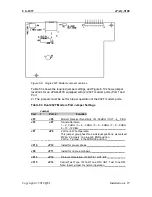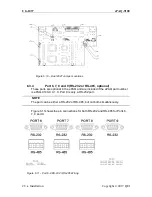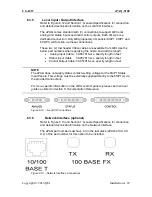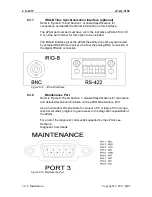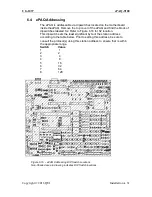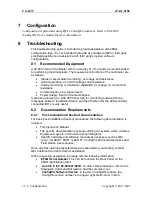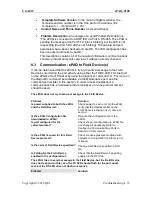
UG-1037
ePAQ-9100
18
Specifications
Copyright © 2017 QEI
The ePAQ 9100 has a wide variety of communications options available. RS-
232, RS-485, Bit-protocol, and modem interfaces are all available, as well as
more modern interfaces such as IRIG (time-synch) dial-up and Ethernet
protocols. Communications timing parameters are handled at the system level;
ensuring proper operations of the communications hardware independently of the
specific protocol. A powerful addition to the ePAQ 9100 is the Ethernet network
adaptor. A separate processor, running a commercial OS, powers it. The
architecture of the platform allows a wide variety of network protocols to be
supported, without impacting the real-time performance of the base system.
Communications between the two processors is handled through a high-speed
dual-port memory interface, without any bus-contention latency issues.
The Ethernet interface provides a wide variety of Ethernet-based networking
protocols such as TCP/IP and OSI, which in turn encapsulate standard SCADA
and automation protocols such as UCA2.0 and DNP3. In addition, standard
network services are supported for remote access and maintenance. FTP, TFTP,
and HTML access are provided for reading and writing configuration information,
as well as for providing data in XML or JavaScript-compatible formats as a Web
Server. Telnet is supported for access to the diagnostic utilities, PPP or SLIP
protocols are available for dial-up applications, and the file system supports NFS
access, for applications that can take advantage of these features. Of course,
any or all of these access methods can be disabled or restricted for security
purposes. In any case, access to the ePAQ 9100 platform is tightly controlled, so
that network access does not affect the real-time performance of the base
platform.
5 Specifications
5.1 General Specifications
5.1.1
Port 1,2 (RS-232) (optional)
Protocols: Asynchronous, byte-oriented
Data Rate: Up to 38.4 Kbps
Push-To-Talk: Open collector, 120mA @12Vdc, sinking
Connector: DB9 Female
5.1.2
Port 1,2 (TELCO) (optional)
Modem: Bell 202T
Protocols: Synchronous/asynchronous, byte or bit-oriented
Data Rate: Up to 1200 baud
Modulation: Frequency Shift Keying (FSK)
Carrier Frequencies: Mark
– 1200 Hz, Space - 2200 Hz, Soft Carrier –
900 Hz
Receive Sensitivity: -30 or
–45 dBm
Transmit Output: -12 to 0 dBm in 3 dBm steps
Line Configuration: 2 or 4 Wire
Line Impedance: 600 ohms
Push-To-Talk: Open collector, 120mA @12Vdc, sinking
Interconnections: RJ-12, 6 pin
























